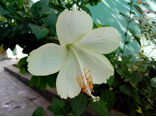Bunga Raya
| Bunga Raya | |
| Scientific Name | Hibiscus rosa-senensis (L.) |
| Order | Malvales |
| Family | Malvaceae |
 |
{slider=Common Name}
Bunga sepatu, kembang sepatu (Malay), rose mallow, chinese hibiscus, china rose, shoe flower (English)
{/slider}
{slider=Description}
Hibiscus rosa-sinensis is a bushy, evergreen shrub with glossy leaves. The shrub can grow between 2.5 to 5 m tall and 1.5-3 m wide. Numerous varieties, cultivars and hybrids are available with flower colors ranging from white through yellow and orange to scarlet and shades of pink with both single and double sets of petals (Wikipedia)
{/slider}
{slider=Plant Material of Interest}
Whole plant (Health from Nature).
{/slider}
{slider=Geographical Distribution}
Native to tropical and subtropical region (Health from Nature).
{/slider}
{slider=Traditional Uses}
Traditionally, the leaves of the plant are believed to cure fatigue and skin diseases. Flowers of H. rosa-sinensis are used in epilepsy, leprosy, bronchial catarrh and diabetes. Fresh root juices are used to treat gonorrhea and the powdered root for menorrhagia (Kumar and Singh, 2012). The root is also traditionally used to treat coughs.
{/slider}
{slider=Chemical Constituents}
|
Plant part |
Name compound |
References |
|
Leaves and stems |
stigmasterol |
Ghani, 2003 |
|
β-sitosterol |
||
|
taraxeryl acetate |
||
|
Flowers |
cyanidin diglucoside |
|
|
flavonoids |
||
|
vitamins |
||
|
thiamine |
||
|
fiboflavin |
||
|
niacin |
||
|
ascorbic acid |
||
|
Flowers (yellow colour flowers) |
quercetin-3-diglucoside |
Rastogi and Mehrortra, 1993 |
|
3,7-diglucoside |
||
|
cyanidin-3,5-diglucoside |
||
|
cyanidin-3-sophoroside-5-glucoside |
||
|
Flowers (ovary of white flowers) |
quercetin-3-diglucoside |
|
|
3,7-diglucoside |
||
|
cyanidin-3,5-diglucoside |
||
|
cyanidin-3-sophoroside-5-glucoside |
||
|
kaempferol-3-xylosylglucoside |
{slider Pharmacology}
|
Pharmacological effect |
Reference/s |
|
Anti tumor |
Serrame and Lim Sylianco, 1995 |
|
Anti oxidant |
Gauthaman et al., 2006 |
|
Anti diabetic |
Sachdewa and Khemani, 2003; Moqbel et al., 2011 |
|
Anti bacterial |
Uddin et al., 2010; Shivananda et al., 2007 |
|
Wound healing |
Shivananda et al., 2007 |
|
Anti-inflammatory |
Vivek et al., 2010 |
{/slider}
{slider=Toxicity Studies}
Presently there are no available reports on the side effects of H. rosa-sinensis. Vasudeva and Sharma (2007), found no toxicity effect of H. rosa-sinensis during antifertility test of Wistar rats. Similarly (Kandhare et al., 2012) found no signs or symptoms such as restlessness, repiratory distress, diarrhea, convusions and coma when albino mice was fed with H. rosa-sinensis. They found that the oral consumption of hydroalcoholic extracts of H. rosa-sinensis leaves was safe up to 5000 mg/kg.
{/slider}
{slider=Reference}
Gauthaman, K.K., Saleem, M.T.S., Thanislas, P.T., Prabhul, V.V., Krishnamoorthy, K.K., Devaraj N.S. and Somasundaram, J.S. 2006. Cardioprotective effect of the Hibiscus rosa sinensis flowers in an oxidative stress model of myocardial ischemic reperfusion injury in rat. BMC Complementary and Alternative Medicine, 6: 32.
Ghani. 2003. In: Review on Hisbiscus rosa sinensis. 2012. Kumar, A., Singh, A. (eds). International Journal of Research in Pharmaceutical and Biomedical Sciences 3(2): 534-538.
Health from Nature. http://www.health-from-nature.net/Hibiscus.html. Accessed on 21 April 2014.
Kandhare, A.D., Raygude, K. S., Gosh, P., Ghule, A.E., Gosavi, T.P., Badole, S.L., Bodhankar, S.L. Effect of hydroalcoholic extract of Hibiscus rosa-sinensis Linn. Leaves in experimental colitis in rats. Asian Pasific Journal of Tropical Biomedicine 2(5): 337-344.
Kumar, A., Singh, A. 2012. Review on Hisbiscus rosa sinensis. International Journal of Research in Pharmaceutical and Biomedical Sciences 3(2): 534-538.
Moqbel, F. S., Naik, P. R., Najma Habeeb, M., Selvaraj, S. 2011. Antidiabetic properties of His Hisbiscus rosa sinensis L. Leaf extract fractions on non-obese diabetic (NOD) mouse. Indian Journal of Experimental Biology. 49: 24-29.
Rastogi and Mehrortra, 1993. In: Review on Hisbiscus rosa sinensis. 2012. Kumar, A., Singh, A. (eds). International Journal of Research in Pharmaceutical and Biomedical Sciences 3(2): 534-538.
Sachdewa,A., Khemani, L.D. 2003. Effect of Hisbiscus rosa sinensis Linn. Ethanol flower extract on blood glucose and lipid profile in streptozotocin induced diabetes in rats. Journal of Ethnopharmacology 89(1): 61-66
Serrame, E., Lim Sylianco, C.Y., 1995. Anti-tumor promoting activity of decoctions and expressed juices from Philippine medicinal plants. Philippine Journal of Sciences 124:275-281.
Shivananda N.B., Sivachandra R.S., Orette F.A. and Chalapathi R.A.V. (2007). Effects of Hibiscus rosa-sinensis L (Malvaceae) on wound healing activity: A preclinical study in a Sprague Dawley rat. Int J Low Extrem Wounds. 6(2): 76-81. Uddin, B., Hossan, T., Paul, S., Ahmed, T., Nahar, T., Ahmed, S. 2010. Antibacterial activity of the ethanol extracts of Hisbiscus rosa sinensis leaves and flowers against clinical isolates of bacteria. Bangladesh Journal of Life Science 22(2): 65-73.
Wikipedia. http://en.wikipedia.org/wiki/Hibiscus_rosa-sinensis. Accessed on 21 April 2014. Vasudeva, N., Sharma, S.K. 2008. Post-coital antifertility activity of Hisbiscus rosa sinensis Linn. Roots. Evidence Based Complementary and Alternative Medicine 5(1): 91-94.
Vivek Tomar, Kannojia, P., Jain, K.N., Dubey, K.S. 2010. Anti-noceceptive and anti-inflammatory activity of leaves of Hisbiscus rosa sinensis. International Journal of Research in Ayurveda and Pharmacy 1(1): 201-205
{/slider}
- Last updated on .
- Hits: 4359
